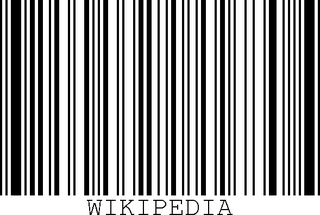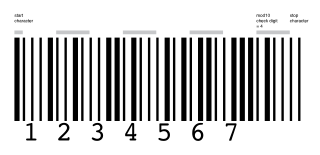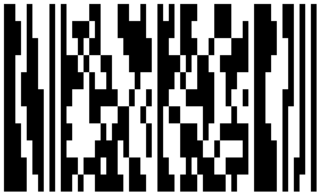
The Universal Product Code is a barcode symbology that is widely used worldwide for tracking trade items in stores.

A barcode or bar code is a method of representing data in a visual, machine-readable form. Initially, barcodes represented data by varying the widths, spacings and sizes of parallel lines. These barcodes, now commonly referred to as linear or one-dimensional (1D), can be scanned by special optical scanners, called barcode readers, of which there are several types.

Code 39 is a variable length, discrete barcode symbology defined in ISO/IEC 16388:2007.
POSTNET is a barcode symbology used by the United States Postal Service to assist in directing mail. The ZIP Code or ZIP+4 code is encoded in half- and full-height bars. Most often, the delivery point is added, usually being the last two digits of the address or PO box number.

PDF417 is a stacked linear barcode format used in a variety of applications such as transport, identification cards, and inventory management. "PDF" stands for Portable Data File. The "417" signifies that each pattern in the code consists of 4 bars and spaces in a pattern that is 17 units (modules) long. The PDF417 symbology was invented by Dr. Ynjiun P. Wang at Symbol Technologies in 1991. It is defined in ISO 15438.

Code 128 is a high-density linear barcode symbology defined in ISO/IEC 15417:2007. It is used for alphanumeric or numeric-only barcodes. It can encode all 128 characters of ASCII and, by use of an extension symbol (FNC4), the Latin-1 characters defined in ISO/IEC 8859-1. It generally results in more compact barcodes compared to other methods like Code 39, especially when the texts contain mostly digits. Code 128 was developed by the Computer Identics Corporation in 1981.

Code 93 is a barcode symbology designed in 1982 by Intermec to provide a higher density and data security enhancement to Code 39. It is an alphanumeric, variable length symbology. Code 93 is used primarily by Canada Post to encode supplementary delivery information. Every symbol includes two check characters.
CPC Binary Barcode is Canada Post's proprietary symbology used in its automated mail sortation operations. This barcode is used on regular-size pieces of mail, especially mail sent using Canada Post's Lettermail service. This barcode is printed on the lower-right-hand corner of each faced envelope, using a unique ultraviolet-fluorescent ink.

The International Article Number is a standard describing a barcode symbology and numbering system used in global trade to identify a specific retail product type, in a specific packaging configuration, from a specific manufacturer. The standard has been subsumed in the Global Trade Item Number standard from the GS1 organization; the same numbers can be referred to as GTINs and can be encoded in other barcode symbologies defined by GS1. EAN barcodes are used worldwide for lookup at retail point of sale, but can also be used as numbers for other purposes such as wholesale ordering or accounting. These barcodes only represent the digits 0–9, unlike some other barcode symbologies which can represent additional characters.
The Postal Alpha Numeric Encoding Technique (PLANET) barcode was used by the United States Postal Service to identify and track pieces of mail during delivery – the Post Office's "CONFIRM" services. It was fully superseded by Intelligent Mail Barcode by January 28, 2013.
Codabar is a linear barcode symbology developed in 1972 by Pitney Bowes Corp. It and its variants are also known as Codeabar, Ames Code, NW-7, Monarch, Code 2 of 7, Rationalized Codabar, ANSI/AIM BC3-1995 or USD-4. Although Codabar has not been registered for US federal trademark status, its hyphenated variant Code-a-bar is a registered trademark.

MSI is a barcode symbology developed by the MSI Data Corporation, based on the original Plessey Code symbology. It is a continuous symbology that is not self-checking. MSI is used primarily for inventory control, marking storage containers and shelves in warehouse environments.

RM4SCC is the name of the barcode character set based on the Royal Mail 4-State Bar Code symbology created by Royal Mail. The RM4SCC is used for the Royal Mail Cleanmail service. It enables UK postcodes as well as Delivery Point Suffixes (DPSs) to be easily read by a machine at high speed.

The Intelligent Mail Barcode (IMb) is a 65-bar barcode for use on mail in the United States. The term "Intelligent Mail" refers to services offered by the United States Postal Service for domestic mail delivery. The IM barcode is intended to provide greater information and functionality than its predecessors POSTNET and PLANET. An Intelligent Mail barcode has also been referred to as a One Code Solution and a 4-State Customer Barcode, abbreviated 4CB, 4-CB or USPS4CB. The complete specification can be found in USPS Document USPS-B-3200. It effectively incorporates the routing ZIP Code and tracking information included in previously used postal barcode standards.
Plessey Code is a 1D linear barcode symbology based on pulse-width modulation, developed in 1971 by The Plessey Company plc, a British-based company. It is one of the first barcode symbology, and is still used rarely in some libraries and for shelf tags in retail stores, in part as a solution to their internal requirement for stock control. The system was first used in the early 1970s by J.Sainsbury to identify all of its products on supermarket shelves for its product restocking system.

David Allais is an American expert and inventor in the fields of bar coding and automatic identification and data capture. As vice president and later president and chief executive officer of Everett, Washington-based Intermec Inc. (NYSE:IN), he built the company from a small startup into the leading manufacturer of bar code and printing equipment. Prior to Allais' role at Intermec, he served as a manager for IBM. Most recently, Allais founded PathGuide Technologies, a Bothell, Washington-based developer of warehouse management systems for distributors.
Industrial 2 of 5. is a variable length, discrete, two width symbology. Industrial 2 of 5 is a subset of two-out-of-five codes.

Codablock is a family of stacked 1D barcodes which was invented in Identcode Systeme GmbH in Germany in 1989 by Heinrich Oehlmann. Codablock barcodes are based on stacked Code 39 and Code 128 symbologies and have some advantages of 2D barcodes.

Matrix 2 of 5 is a variable length, discrete, two width symbology. Matrix 2 of 5 is a subset of two-out-of-five codes. Unlike Industrial 2 of 5 code, Matrix 2 of 5 can encode data not only with black bars but with white spaces.

MicroPDF417 is two-dimensional (2D) stacked barcode symbology invented in 1996, by Frederick Schuessler, Kevin Hunter, Sundeep Kumar and Cary Chu from Symbol Technologies company. MicroPDF417 consists from specially encoded Row Address Patterns (RAP) columns and aligned to them Data columns encoded in "417" sequence which was invented in 1990. In 2006, the standard was registered as ISO/IEC 24728:2006.


















